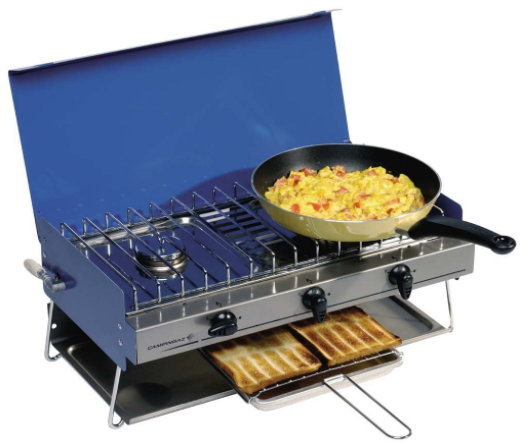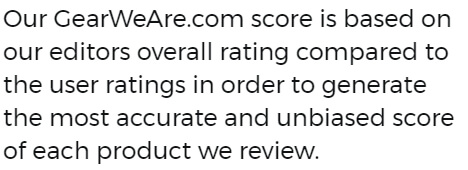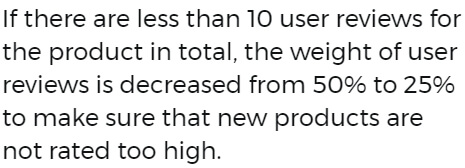Campingaz Camping Chef stove
Summary: Functional rather than pretty (and stored in its own carrying bag), the Campingaz Camping Chef is there for a purpose rather than to be admired. The two gas rings do a good job and the whole unit can accommodate a couple of pans or pots without fuss, but the grill is definitely the weakest link.
Editor's Pros & Cons
Pros
Reasonably priced
Excellent gas flow
Fueled by Butane/Propane
Simple controls
Cons
The grill underneath falls short
In-Depth Review
If there's one thing I've learned over the years it's that food is pretty important. In fact I'd go so far as to say that it's more-or-less essential.
Curry and fish & chips - the consumption of which is to be actively encouraged - are all well and good but when you're camping for more than a weekend there will always come a time when you have to rustle up something yourself. Pot Noodles don't count for the purposes of this review.
This is where the Campingaz Camping Chef stove comes in handy. Comprising two mid-sized gas burners with a ‘radiant burner’ underneath (aka a grill) it's a simple affair - it's certainly no Aga - which is more about function than form. It's designed to help you make simple meals and the odd breakfast fry-up without any fuss, and it does. We’ve cooked for four a few times on it without any effort and Mrs Muz insists we once managed to cater for... get this... eight! She’s dead organised though, so that’s half the battle won from the off.
Butane gas (or propane, if preferred) is delivered from your bottle via a standard tough rubber hose on one end of which is a regulator to make sure you don't blow yourself up before your eggs are done, and a strong jubilee clip attaches it to the stove for much the same reason.
A pair of thin-but-reasonably-sturdy metal legs unfold from the unit to give the whole thing a few inches of height and stability, so the only way anything is going to fall off is if you've set it up on uneven ground or you have a saboteur in your midst. Or a dog. Or a child. Or a Nite Ize flying disc.
Perhaps all three in the immediate vicinity - anyway, you get the idea.
Gas flow is certainly strong enough to deliver some reasonably serious heat to your pans of chilli con carne and rice (ignition is via a good old fashioned match) and you'll find them bubbling merrily away in no time even though adjustment of the flames is pretty basic. Don't expect it to be like your hob at home for fine-tuning.
The metal lid on the whole Camping Chef ensemble also acts as a windbreak but it only protects the back of the unit and when in position it stands a little far back from the burners. If the breeze changes direction you'll need to come up with something ingenious - and fire proof - because there's enough of a gap between the burners and the bottom of the pan for the wind to get in and disturb the flame, wasting precious fuel while significantly increasing cooking time.
So all fairly well and good so far, providing you've planned ahead.
Until you decide you want to use the grill.
This is where the Camping Chef fails big-time although, to be fair, I'm yet to see a camping stove which has a decent grill. Basically, if you want toast you'd be better off waving a headtorch at your bread for all the good it does.
Okay, maybe that’s a bit harsh. Let me explain. First of all the radiant burner is far too small and weedy. The entire stove is 20 inches long but the grill burner is just six inches of that. The stove is also 11 inches front-to-back but the burner is less than two-and-a-half inches wide. Realistically your only choice is to have one tiny (mini toastie loaf-sized) slice of bread underneath or nothing at all. Even if you decided to go mental and try for two tiny slices of bread you'll find yourself hampered by the titchy metal grill pan which might accommodate them, but only if you force the issue. Another problem is that the wire grille of the grill pan sits a full three inches below the burner at best (you can make it even lower), meaning the heat – hindered by any breeze that’s around – has some distance to travel before it does what it’s meant to.
Let's assume you're in an optimistic mood and have squeezed two slices on for a laugh. The results are as follows: two tiny slices of bread are now two tiny slices of slightly warmer bread with, perhaps, the vaguest hint of a tan line on one. Not great and not really toasty either. You can invest some time and effort moving your bread around to catch an even amount of heat if you want – and thereby creating a passable impression of toast as a result, but on the few occasions I’ve fancied it I’ve just stuck a fork in a slice of bread and waved it around over one of the rings on full blast.
That method isn’t exactly ideal for bacon though, although sliced pig does cook eventually under the grill if you fart about moving your rashers from here to there and back again for a while. Ditto for sausages.
Finally comes cleaning. This is a problem all such stoves suffer, unfortunately, and is more of an issue with me than the Camping Chef...
Whereas at home you can take individual parts of your hob to the sink and wash them at your leisure, doing roughly the same thing in a field is a bit of a pain, even though the Camping Chef does come to pieces for cleaning purposes. But cleaning grease off the various fixed surfaces of its main chassis is also a ball-ache, even if you take it to your site’s dedicated kitchen sink, although it’s not impossible.
Actually... forget that last paragraph. It’s not Campingaz’s fault I’m bone idle.
Curry and fish & chips - the consumption of which is to be actively encouraged - are all well and good but when you're camping for more than a weekend there will always come a time when you have to rustle up something yourself. Pot Noodles don't count for the purposes of this review.
This is where the Campingaz Camping Chef stove comes in handy. Comprising two mid-sized gas burners with a ‘radiant burner’ underneath (aka a grill) it's a simple affair - it's certainly no Aga - which is more about function than form. It's designed to help you make simple meals and the odd breakfast fry-up without any fuss, and it does. We’ve cooked for four a few times on it without any effort and Mrs Muz insists we once managed to cater for... get this... eight! She’s dead organised though, so that’s half the battle won from the off.
Butane gas (or propane, if preferred) is delivered from your bottle via a standard tough rubber hose on one end of which is a regulator to make sure you don't blow yourself up before your eggs are done, and a strong jubilee clip attaches it to the stove for much the same reason.
A pair of thin-but-reasonably-sturdy metal legs unfold from the unit to give the whole thing a few inches of height and stability, so the only way anything is going to fall off is if you've set it up on uneven ground or you have a saboteur in your midst. Or a dog. Or a child. Or a Nite Ize flying disc.
Perhaps all three in the immediate vicinity - anyway, you get the idea.
Gas flow is certainly strong enough to deliver some reasonably serious heat to your pans of chilli con carne and rice (ignition is via a good old fashioned match) and you'll find them bubbling merrily away in no time even though adjustment of the flames is pretty basic. Don't expect it to be like your hob at home for fine-tuning.
The metal lid on the whole Camping Chef ensemble also acts as a windbreak but it only protects the back of the unit and when in position it stands a little far back from the burners. If the breeze changes direction you'll need to come up with something ingenious - and fire proof - because there's enough of a gap between the burners and the bottom of the pan for the wind to get in and disturb the flame, wasting precious fuel while significantly increasing cooking time.
So all fairly well and good so far, providing you've planned ahead.
Until you decide you want to use the grill.
This is where the Camping Chef fails big-time although, to be fair, I'm yet to see a camping stove which has a decent grill. Basically, if you want toast you'd be better off waving a headtorch at your bread for all the good it does.
Okay, maybe that’s a bit harsh. Let me explain. First of all the radiant burner is far too small and weedy. The entire stove is 20 inches long but the grill burner is just six inches of that. The stove is also 11 inches front-to-back but the burner is less than two-and-a-half inches wide. Realistically your only choice is to have one tiny (mini toastie loaf-sized) slice of bread underneath or nothing at all. Even if you decided to go mental and try for two tiny slices of bread you'll find yourself hampered by the titchy metal grill pan which might accommodate them, but only if you force the issue. Another problem is that the wire grille of the grill pan sits a full three inches below the burner at best (you can make it even lower), meaning the heat – hindered by any breeze that’s around – has some distance to travel before it does what it’s meant to.
Let's assume you're in an optimistic mood and have squeezed two slices on for a laugh. The results are as follows: two tiny slices of bread are now two tiny slices of slightly warmer bread with, perhaps, the vaguest hint of a tan line on one. Not great and not really toasty either. You can invest some time and effort moving your bread around to catch an even amount of heat if you want – and thereby creating a passable impression of toast as a result, but on the few occasions I’ve fancied it I’ve just stuck a fork in a slice of bread and waved it around over one of the rings on full blast.
That method isn’t exactly ideal for bacon though, although sliced pig does cook eventually under the grill if you fart about moving your rashers from here to there and back again for a while. Ditto for sausages.
Finally comes cleaning. This is a problem all such stoves suffer, unfortunately, and is more of an issue with me than the Camping Chef...
Whereas at home you can take individual parts of your hob to the sink and wash them at your leisure, doing roughly the same thing in a field is a bit of a pain, even though the Camping Chef does come to pieces for cleaning purposes. But cleaning grease off the various fixed surfaces of its main chassis is also a ball-ache, even if you take it to your site’s dedicated kitchen sink, although it’s not impossible.
Actually... forget that last paragraph. It’s not Campingaz’s fault I’m bone idle.













